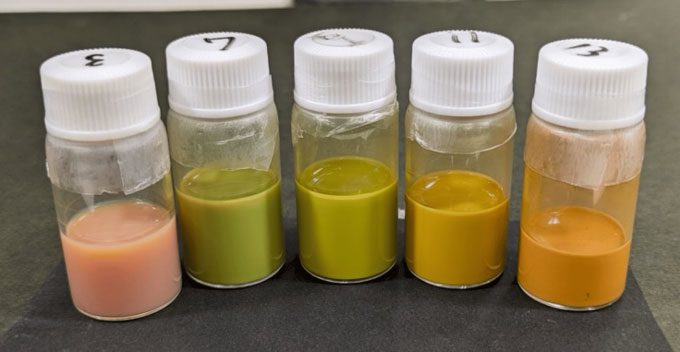A new type of ink weighs less than 0.5 grams per square meter, significantly reducing the weight of aircraft paint, thereby saving fuel.
A research team at Kobe University has developed a new type of structural color ink, which is only 100 – 200 nanometers thick and ultra-light, as reported by New Atlas on January 30. The new study has been published in the journal ACS Applied Nano Materials.

The nano spheres in a methanol suspension have different colors when spread on a surface as a monolayer. (Photo: Fujii Minoru).
Conventional paints and pigments absorb certain wavelengths of light and reflect others, but they tend to degrade at the molecular level, leading to fading. In contrast, structural colors reflect the entire spectrum of light from parallel nano structures, establishing the appropriate spacing to eliminate certain wavelengths. This effect gives butterfly wings and peacock feathers their iridescent, dazzling colors. Because light is not absorbed but merely reflected from the structures, the colors do not fade. However, this effect often heavily depends on the viewing angle, resulting in beautiful but somewhat unusual iridescent properties compared to most industrial pigments.
In the new study, experts developed a new method to create structural colors. Instead of using parallel nano structures, they employed tiny crystalline silicon spheres. Through Mie resonance phenomenon, these nano-sized spheres reflect some wavelengths much stronger than others, with the wavelengths also varying according to particle size. In other words, changing the particle size alters the color of the material. There is no iridescent effect because the spheres reflect light in all directions.
Notably, the strongest colors occur when the nano spheres have space around them rather than being tightly compacted. “A layer of sparsely distributed silicon nano particles with a thickness of 100 – 200 nanometers provides bright colors and weighs less than 0.5 grams per square meter. This makes our silicon nano particles one of the lightest color coatings in the world,” said materials engineer Sugimoto Hiroshi from Kobe University.
Aerospace is one of the fields that requires super-light paints. Passenger aircraft carry about 272 – 544 kg of paint. “If we use this nano sphere ink, we could reduce the weight to below 10% of that amount”, Sugimoto stated. Reducing weight will help aircraft save fuel. Additionally, since the new structural color ink does not fade like traditional paints, it also helps save on painting costs.


















































